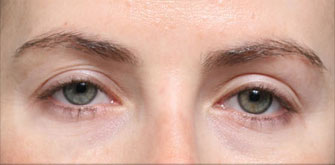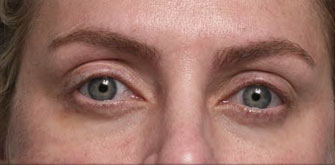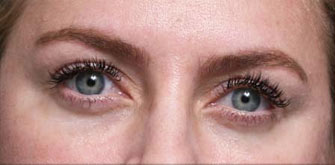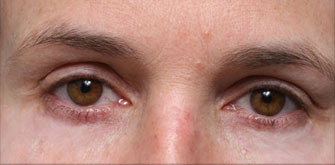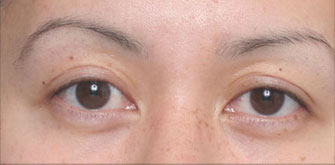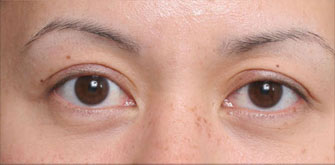 View Additional Case Studies
View Additional Case Studies
Another common issue is residual fullness in the inner corner of the eyelids. In the immediate post-operative period, this can be related to swelling. However, once you are about two months or more out from surgery, the persistence of this fullness is generally consistent with unaddressed orbital fat that can protrude in the inner corners. Very often Dr. Steinsapir finds that this concern was present before surgery but left undiscussed as a cosmetic concern by the patient and unaddressed surgically by the surgeon.
This can be corrected but a surgical procedure is needed to remove this fat. Due to the possible contribution of lingering swelling after surgery, Dr. Steinsapir generally advocates waiting approximately 6 months before undertaking revisional surgery to remove this concern should it persist.
By far the largest group of upper eyelid issues are related. Dr. Steinsapir collectively refers to them as the Post Upper Blepharoplasty Syndrome (PUBS). Others have called this the Post Blepharoplasty Look. However, “look” makes it sound as though the changes are intentional and for the most part, they are not. Dr. Steinsapir has carefully analyzed these findings patients who have come to him for care after unsatisfactory surgery elsewhere. The related spectrum of findings include a hollow upper eyelid that looks as if too much skin and upper eyelid fat were removed, upper eyelid ptosis or droopy eyelids, upper eyelid lash ptosis, and a compensatory eyebrow elevation.
In many individuals with these changes, the upper eyelid platform, which is the space from the upper eyelid lashes to the upper eyelid crease appears too long. The two sides are often asymmetric. Unless your surgeon really understands eyelids, it is unlikely that they understand what they are looking at. They may even believe that the way your upper eyelids look after surgery is precisely what the upper eyelids should look like! Have you had that conversation with a surgeon where you are trying to tell them that you are unhappy with the outcome of surgery but they are trying to tell you how great the surgery was?
Dr. Steinsapir has made a careful study of eyelids like this to determine not just how to fix them but also what is going on inside the eyelid to make them look like this. Post Upper Blepharoplasty Syndrome is a spectrum. That means you might have every feature described or only some of the features such as a long upper eyelid platform and upper eyelid ptosis. Some of these issues may be more pronounced than others. The common basis for the syndrome is the change in the upper eyelid fold. These eyelids go from being “outies” to “innies.” What has changed? It has been a commonly held belief that too much skin and fat has been removed from these eyelids. This belief is so strong that patients are often told that their upper eyelid creases can’t be lowered after unsatisfactory upper eyelid surgery.
That is not what Dr. Steinsapir has found in repairing these eyelids. Instead, he discovered that these eyelids look this way do due to internal scaring caused by the original blepharoplasty. At the time of the original surgery, the surgeon removes upper eyelid skin and also opens a structure called the orbital septum. This is a loose membranous plane of connective tissue that separates the eyelid from the deeper orbital structures including fat that contributes to the fullness of the upper eyelid fold.
Quite often the surgeon may be conservative in the removal of this fat but scaring of the fat occurs after surgery. This mats down the orbital fat and makes the upper eyelid hollow. Also, the orbital septum will scar and contract. When this happens, the septum, which is attached to the tendon that opens the upper eyelid, will pull on the tendon.
Over time, this causes the central portion of the upper eyelid tendon to centrally separate from the lower edge of the upper eyelid. When this happens, the upper eyelid becomes heavy, droopy, or ptotic. This can happen very quickly after surgery or it can occur over a longer time frame. This trauma to the levator aponeurosis causes a specific type of ptosis called a white line levator disinsertion.
These observations are critical because it’s the basis for the rational repair of these eyelids. Surgeons who attempt to repair these heavy upper eyelids are often surprised when the fix doesn’t work. That is because surgeons often attempt to repair these heavy upper eyelids with a ptosis surgery called a Mueller’s muscle conjunctival resection (MMCR). This is a very popular form of ptosis surgery. However, it only works when the levator aponeurosis, the tendon that lifts the upper eyelid, is in the proper position.
Dr. Steinsapir discovered that is often not the case for these Post Upper Blepharoplasty Syndrome eyelids. For that reason, Dr. Steinsapir does not use the Muellerectomy to repair these eyelids. He uses a crease lowering technique developed by South Korean eyelid surgeons. He has adapted these methods for both Western and Asian eyelids.
The disinserted tendon is found in the scar tissue created at the time of the original eyelid surgery. This is carefully dissected from the scar tissue and put back down into the upper eyelid where it is used to perform ptosis surgery. Dr. Steinsapir seldom finds it necessary to graft fat into these eyelids. By mobilizing the fat that is still present but matted down by scar tissue, this fat becomes available once again to add volume to the upper eyelid fold.
By correcting the ptosis, lowering the crease, and revitalize the upper eyelid, the eyelid is not just restored but is actually made to look even better by actually achieving the type of enhancements that prompted you to seek eyelid surgery in the first place. It is possible to restore your eyes so they can once again be your best feature.

